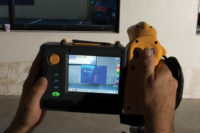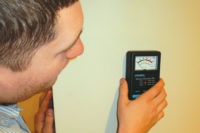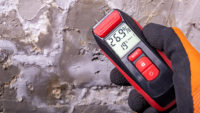From Odor Control to Moisture Meters: A Look at Today’s Trends










Breath fresheners generated sales of $658.4 million from April 2012 through April 2013, according to the website www.statista.com. If people are willing to pay that much for masking their bad breath, how much more would they pay to take care of the stench in their business or home? After all, bad odors are unacceptable in our society.
Technology exists and affects almost every area of our daily life. Odor control isn’t exempt. Gone are the days of throwing flower petals before the king to keep him from smelling the foulness of the crowd. Advanced chemistry and technology is doing the job today.
I’d like to focus on three odor control technologies that I see continuing to make an impact on how we deal with odors.
Hydroxyl Generators
A safer alternative to ozone generators, hydroxyl generators are gaining more and more support and use. What is a hydroxyl? According to one manufacturer, “Hydroxyls (OH) are molecules consisting of one oxygen atom and one hydrogen atom. They are safe, naturally occurring molecules that are created in our atmosphere when the sun’s ultraviolet rays react with water vapor. They play a critical role in cleaning the earth’s atmosphere and are often referred to as the ‘detergent’ of the atmosphere. They can be used to break down volatile organic compounds (VOCs), chemical fumes, gases, vapors and unpleasant odors.” They have been used in several other industries such as meat rendering plants, sewage treatment plants and trash facilities, but are now available in portable units for disaster restoration.
Nanotechnology Cartridges
These employ the same technology used by our military for decontaminating our soldiers after a chemical attack. It uses earth minerals – highly reactive metal oxides. One example is Titanium Dioxide which is used in many paints, sunscreens and make up. The problem with most metal oxides is that when grown naturally, their crystals don’t have much surface area. The surface of the crystals is where the reaction occurs to eliminate the chemicals producing the bad odors – and chemicals you can’t see, but are dangerous such as after a fire.
A technique emerged to regrow these earth minerals to increase their surface area. The analogy that seems to help many is a popcorn kernel. The raw kernel doesn’t have much surface area, but pop it and now it is much larger. The manufacturers have found a way to put that into cartridges to be used with air filtration devices (AFDs) and dehumidifiers. Nothing is put into the air. All the bad odors and harmful molecules are brought back to the cartridge to be adsorbed or destroyed as it reacts with the earth minerals. With the addition to a HEPA filter, it also removes the small respirable particulate that is so dangerous to breathe and can’t be removed by our lungs.
Dry Vapor Technology
Just as the medical field has advanced exponentially with new drugs and techniques, many have turned back to alternative medicine that has been around for centuries. This last odor control technology fits this pattern, but was re-introduced in 1979 as a safe and effective odor treatment for cancer and burn wards, so you know it is safe for technicians and building occupants, including pets.
Dry Vapor utilizes a proprietary blend of essential oils to provide a safe, effective treatment of all kinds of organic odors that home and business owners complain about. These are deployed into the air through airflow passed by a membrane with the blend. The product volatilizes into the air and neutralizes the bad odor molecules as it reacts with it – it’s not just a mask to cover the odor. It treats the air, structure and contents at the same time, since the molecules are so small, and can penetrate deeply into crevices and surfaces. It is highly effective in smoke damage restoration, but can be used for a variety of odors such as trauma, water damage, cooking, animals, etc. Use it as a first (and continuing) step for a fire loss for immediate odor suppression and to remedy “heightened awareness syndrome” or “psychological odors.” It also provides a very safe product and a pleasant odor for those working and living in the environment, as well as for those with an aversion to strong synthetic deodorizes and perfumes.
METERS
Let’s face it. Sensing technology hasn’t really changed much in decades, but I do see three major trends in improvements with new and combined features.
- All-in-one/multi-meter units: These are or have typically been meters with three main functions: thermo-hygrometer, invasive moisture sensing and non-invasive moisture sensing. There are two philosophies on this. The first is it’s beneficial to have several meters that can be used by multiple people simultaneously and if one of the meters doesn’t work, you will have the others to use. The second is that you only need to carry one convenient meter that does it all. I see a split of users, but as these all-in-one meters improve on their user interface with screens that are menu driven, they are finding more and more fans. They are adding more functions like surface temperatures (through infrared or k-type probes) and Bluetooth connections to record measurements on Infrared camera pictures.
- New features for all-in-one and stand-alone models: The thermo-hygrometer function now has many, if not all of these features: air temperature (dry bulb and wet bulb), relative humidity, dew point, grains per pound, vapor pressure and enthalpy (in British and Celsius measurement). The scales can now be wood species specific, temperature adjusted automatically and other material specific like drywall and concrete. One feature that is included, but not utilized or programmed well, yet, is data logging. I believe this will be an area to see improvement.
- Remote monitoring and control: This is an area of sensing that is ever improving – not the way sensing is done, but how to utilize it better. Units today are easy to connect to the Internet and can monitor air temperature, relative humidity, moisture content, GPP, surface temperature and power consumption for equipment status (on or off). They can alert technicians by e-mail or text messages based upon user programmed options. They can turn on and off equipment based on readings or be manually controlled remotely. With their data logging features, they can provide reports and data that are protected from being manipulated to show transparency and justify results to adjusters and building owners. All this information can be accessed or downloaded through the Internet by computer, tablet or mobile phone. As I’ve stated many times, I don’t see remote monitoring so much as a means of replacing daily visits, but to see problems much faster to make corrections. Hence, situations like the improper setup of equipment, malfunctioning equipment or clients turning off equipment is where I see this technology having value.
Technology is changing the way we process restoration projects. Keep up on what is happening. Read trade magazines, take classes, visit your local distributor, talk to other professionals and contact manufacturers. I like a quote by the late John Wooden, which I believe applies to everyone: “It’s what you learn after you know it all that counts.” If you aren’t learning and progressing, you are probably going to fall behind.
Looking for a reprint of this article?
From high-res PDFs to custom plaques, order your copy today!










